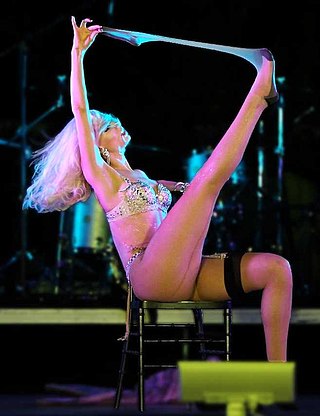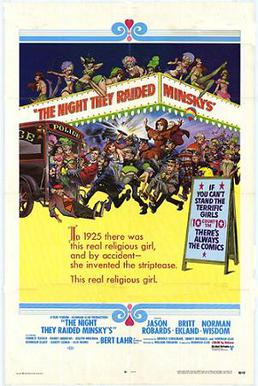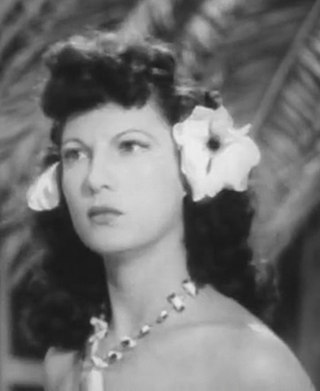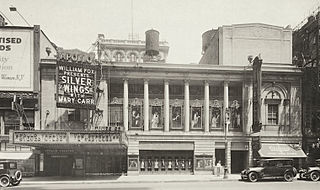
A striptease is an erotic or exotic dance in which the performer gradually undresses, either partly or completely, in a seductive and sexually suggestive manner. The person who performs a striptease is commonly known as a "stripper" or an "exotic" or "burlesque" dancer.

The Ziegfeld Follies were a series of elaborate theatrical revue productions on Broadway in New York City from 1907 to 1931, with renewals in 1934, 1936, 1943, and 1957. They became a radio program in 1932 and 1936 as The Ziegfeld Follies of the Air.

A burlesque is a literary, dramatic or musical work intended to cause laughter by caricaturing the manner or spirit of serious works, or by ludicrous treatment of their subjects. The word derives from the Italian burlesco, which, in turn, is derived from the Italian burla – a joke, ridicule or mockery.

Charles Strouse is an American composer and lyricist best known for writing the music to such Broadway musicals as Bye Bye Birdie, Applause, and Annie.
Harry Steppe, March 16, 1888 – November 22, 1934 was a Russian Jewish-American actor, musical comedy performer, headliner comedian, writer, librettist, director and producer, who toured North America working in Vaudeville and Burlesque. Steppe performed at several well-known theaters on the Columbia, Mutual and Orpheum circuits. Steppe was one of Bud Abbott's first partners.
Mara Gaye, born Marjorie Helen Ginsberg in The Bronx, New York, was a professional showgirl, dancer with the Radio City Music Hall Rockettes (1938–1943), and exotic burlesque striptease dancer of the 1940s through the 1960s. She also performed under the name Marjorie Gaye.

The Night They Raided Minsky's is a 1968 American musical comedy film written and produced by Norman Lear, with music and lyrics by the duo of Charles Strouse and Lee Adams, and directed by William Friedkin. Based on a 1960 novel by Rowland Barber, the film is a fictional account of the invention of the striptease at Minsky's Burlesque in 1925. It stars Jason Robards, Britt Ekland, Norman Wisdom, Forrest Tucker, Harry Andrews, Denholm Elliott, Elliott Gould and Bert Lahr.

Ann Corio was a prominent American burlesque stripper and actress. Her original surname was Coiro, changing it to Corio for stage purposes and because some family members did not approve of her profession.

Rags Ragland was an American comedian and character actor.
Minsky's Burlesque refers to the brand of American burlesque presented by four sons of Louis and Ethel Minsky: Abraham 'Abe' Bennett Minsky (1880–1949), Michael William 'Billy' Minsky (1887–1932), Herbert Kay Minsky (1891–1959), and Morton Minsky (1902–1987). They started in 1912 and ended in 1937 in New York City. Although the shows were declared obscene and outlawed, they were rather tame by modern standards.

Neo-burlesque, or new burlesque, is the revival and updating of the traditional American burlesque performance. Though based on the traditional burlesque art, the new form encompasses a wider range of performance styles; neo-burlesque can include anything ranging from classic striptease to modern dance to theatrical mini-dramas to comedic mayhem.
Hinda Wausau (1906–1980) aka Hinda Wassau, Hinda Wasau, or Hindu Wausau, was a star stripteaser in burlesque. She claimed, and has been credited with, inadvertently inventing the striptease around 1928 at either the Haymarket or State-Congress Theater in Chicago when her costume started coming off during a shimmy dance.

The Howard Athenæum (1845–1953), also known as Old Howard Theatre, in Boston, Massachusetts, was one of the most famous theaters in Boston history. Founded in 1845, it remained an institution of culture and learning for most of its years, finally closing in 1953. It was demolished in 1962 after a fire in June 1961.

Casey Nicholaw is an American theatre director, choreographer, and performer. He has been nominated for several Tony Awards for his work directing and choreographing The Drowsy Chaperone (2006), The Book of Mormon (2011), Aladdin (2014), Something Rotten! (2015), Mean Girls (2018), The Prom (2019), and Some Like It Hot (2023) and for choreographing Monty Python's Spamalot (2005), winning for his co-direction of The Book of Mormon with Trey Parker and his choreography of Some Like It Hot. He also was nominated for the Drama Desk Awards for Outstanding Direction and Choreography for The Drowsy Chaperone (2006) and Something Rotten! (2015) and for Outstanding Choreography for Spamalot (2005).

The Apollo Theatre was a Broadway theatre whose entrance was located at 223 West 42nd Street in Manhattan, New York City, while the theatre proper was on 43rd Street. It was demolished in 1996 and provided part of the site for the new Ford Center for the Performing Arts, now known as the Lyric Theatre.
Star and Garter is a 1942 American musical revue starring comedian Bobby Clark and produced by Mike Todd. The show, which opened at Broadway's Music Box Theatre on 24 June 1942, was a smash hit, closing on 4 December 1943 after 609 performances.

The Columbia Amusement Company, also called the Columbia Wheel or the Eastern Burlesque Wheel, was a show business organization that produced burlesque shows in the United States between 1902 and 1927. Each year, between three and four dozen Columbia burlesque companies would travel in succession round a "wheel" of theaters, ensuring steady employment for performers and a steady supply of new shows for participating theaters. For much of its history the Columbia Wheel promoted relatively "clean" variety shows featuring comedians and pretty girls. Eventually the wheel was forced out of business due to changing tastes and competition from its one-time subsidiary and eventual rival, the Mutual Burlesque Association, as well as cinemas and cruder stock burlesque companies.
Isidore H. Herk was a burlesque manager who played a major role in the evolution of this entertainment before World War II. His show at the Gaiety Theatre, closed in 1941, was the last burlesque show on Broadway.

The Columbia Theatre was an American burlesque theater on Seventh Avenue at the north end of Times Square in Midtown Manhattan, New York City. Operated by the Columbia Amusement Company between 1910 and 1927, it specialized in "clean", family-oriented burlesque, similar to vaudeville. Many stars of the legitimate theater or of films were discovered at the Columbia. With loss of audiences to cinema and stock burlesque, the owners began to offer slightly more risqué material from 1925. The theater was closed in 1927, renovated and reopened in 1930 as a cinema called the Mayfair Theatre. It went through various subsequent changes and was later renamed the DeMille Theatre. Nothing is left of the theater.

The Mutual Burlesque Association, also called the Mutual Wheel or the MBA, was an American burlesque circuit active from 1922 until 1931. Controlled by Isidore Herk, it quickly replaced its parent company and competitor, the Columbia Amusement Company, as the preeminent burlesque circuit during the Roaring Twenties. Comedians Bud Abbott, Lou Costello, Harry Steppe, Joe Penner, Billy Gilbert, Rags Ragland, and Billy Hagan, as well as stripteasers Ann Corio, Hinda Wausau, Gypsy Rose Lee, and Carrie Finnell, performed in Mutual shows. Mae West appeared in Mutual shows from 1922 to 1925. Mutual collapsed during the Great Depression.



















